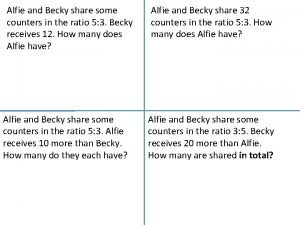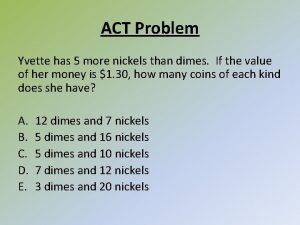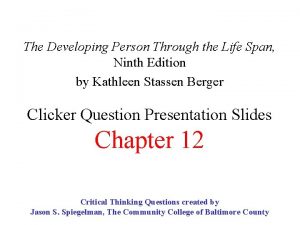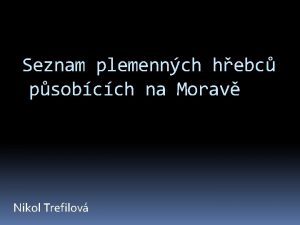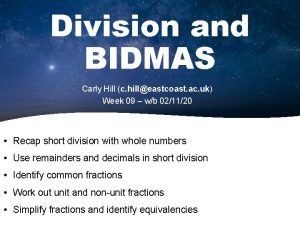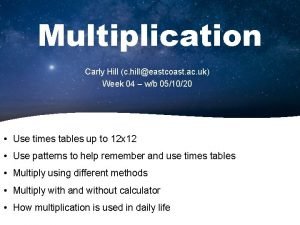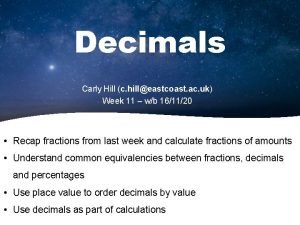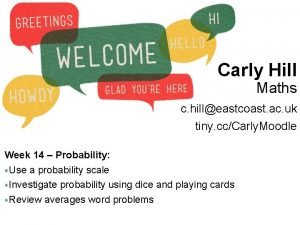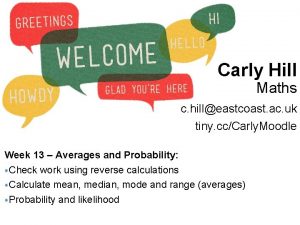Division Carly Hill c hilleastcoast ac uk Week















- Slides: 15

Division Carly Hill (c. hill@eastcoast. ac. uk) Week 08 – w/b 19/10/20 • Recap non-calculator addition, subtraction and multiplication • Recap place value and decimals • Identify sequences and count on to work out next numbers • Use calculator and non-calculator methods of division • Use BIDMAS when working with more than one operation

KWL Chart What I Know What I Want to know What I have Learned

Recap • Addition, subtraction and multiplication practice: • 62 – 41 = • 304 – 187 = • 109 – 75 = • 807 – 273 = • 94 + 17 = • 1026 + 729 = • 327 + 901 = • 2284 + 30298 = • 7 x 11 = • 18 x 63 = • 147 x 73 = • 204 x 86 =

Estimating Round these numbers to the nearest 10, then use these to answer the questions: • 37 + 9 = • 11 + 16 = • 53 – 21 = • 98 – 49 = • 106. 2 + 86. 6 = • 304. 25 + 101. 68 = • 346. 01 – 123. 97 = • 582. 8 – 384. 2 = • 250 – 12. 948 =

Place value • Fill in the missing place values: • Break down the number 3, 287, 263 using the place value chart above. • What is the value of the 5 in the number 261. 051?

Sequences • These sequences are arithmetic sequences. Find the difference between each one and keep adding it to continue the sequence. • Carry on these sequences (write the next five in the sequence): • 40, 50, 60, 70, 80 • 300, 400, 500 • 150, 200, 250, 300 • 75, 85, 95

Sequences Write the first five numbers in a sequence for each of these descriptions. Carry on a sequence where: • It is all even numbers 2, 4, 6, 8, 10 • It adds 5 each time 5, 10, 15, 20, 25 • Each number is 3 bigger than the last 3, 6, 9, 12, 15 • The next number is half of the previous one 100, 50, 25, 12. 5, 6. 25 • All numbers are in the 6 times table 6, 12, 18, 24, 30 • It is Fibonacci (next number is the last 2 added together) 1, 1, 2, 3, 5

Division is sharing into equal groups. We use the ÷ sign. Sometimes, computers use / instead. We can draw objects to help us share them: Dividing is the opposite of multiplying. It is not commutative (it matters which way around the numbers are) This method works best with smaller numbers There are 12 chocolates and 3 friends want to share them. How can they share them fairly? 12 ÷ 3 = 4 Examples here: https: //www. mathsisfun. com/numbers/division. html

Division Have a go at these examples (try without a calculator first, then check your answers with a calculator): • • • 80 ÷ 8 = 42 ÷ 7 = 72 ÷ 9 = 45 ÷ 5 = 28 ÷ 7 = 21 ÷ 7 = 17 ÷ 8 = 56 ÷ 7 = 40 ÷ 10 = 48 ÷ 8 = • 91 ÷ 8 = • 104 ÷ 3 = • 762 ÷ 9 = • 1062 ÷ 4 = • 86 ÷ 7 =

Division When numbers can’t be shared perfectly, we use remainders. These tell us how many are left over after sharing. Show remainders for these questions: • 21 ÷ 5 = • 12 ÷ 7 = • 10 ÷ 3 = • 15 ÷ 4 = • 26 ÷ 5 = • 30 ÷ 8 = • 48 ÷ 5 = Check answers: https: //www. mathsisfun. com/definitions/division. html

Short division • Short division is also called the bus stop method. • It helps us work with bigger numbers. • It looks like this: Have a go: • 80 ÷ 2 = • 60 ÷ 3 = • 35 ÷ 5 = • 28 ÷ 7 = • 72 ÷ 8 = 950 ÷ 4 = • 126 ÷ 4 = • 91 ÷ 7 = Watch this video for an example: https: //www. youtube. com/watch? v=g. Ad 85 C 4 u. Wqw • 492 ÷ 3 = • 716 ÷ 5 = • 1736 ÷ 8 =

Short division More good explanations and examples here: Without remainders: https: //www. mathswithmum. com/short-division-without -remainders/ With remainders: https: //www. mathswithmum. com/short-division-withremainders/

Short division We can turn those remainders into decimals to get a more accurate and precise answer: 846 ÷ 4 = 211 r 2 4|846 Have a go: 37 ÷ 2 = 61 ÷ 5 = 846 ÷ 4 = 211. 5 4 | 8 4 6. 20 Add a 0, carry the remainder and keep going until there are no remainders left (Examples here: https: //www. mathswithmum. com/shortdivision-with-decimal-remainders/) 49 ÷ 5 = 121 ÷ 4 = 216 ÷ 5 = 382 ÷ 3 =

Division recap Work through the division section of My. Maths: https: //static. mymaths. co. uk/xml/player/v 2. 2. 9/build/in dex. html? content. Path=. . /en/primary/number/multip ly_divide_written/short_division_lesson

BIDMAS Brackets, Indices, Division, Multiplication, Addition, Subtraction (also called BODMAS, PEMDAS or BEDMAS) • BIDMAS tells you the order to work out a calculation: Brackets first Have a go: Indices (squared 2, cubed 3) 6+3 x 4= Division and Multiplication (work left to right) 11 + 5 – 3 = Addition and Subtraction (work left to right) 10 ÷ 2 + 3 = 4 + 2 x 3 = 6, 6 + 4 = 10 9 – 4 + 3 = 9 – 4 = 5, 5 + 3 = 8 15 – 6 + 1 = 57 x 3 ÷ 6 + 4 = 106 ÷ 3 – 9 + 17 = More examples: https: //www. mathsisfun. com/operation-order-bodmas. html
 Week by week plans for documenting children's development
Week by week plans for documenting children's development Ringo ma (@ ringomaa)
Ringo ma (@ ringomaa) Carly and james share some money in the ratio 5:3
Carly and james share some money in the ratio 5:3 Carly
Carly Pxrxt
Pxrxt Carly brookfield
Carly brookfield Carly coombs
Carly coombs Carly has 2 more nickels
Carly has 2 more nickels The developing person through the life span 9th edition
The developing person through the life span 9th edition Psychoanalytic
Psychoanalytic Hanson wok
Hanson wok Carly mitchell
Carly mitchell Carly steron
Carly steron Carly shockey
Carly shockey Hope witsell
Hope witsell Dr carly donahue
Dr carly donahue


